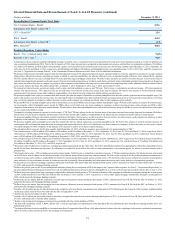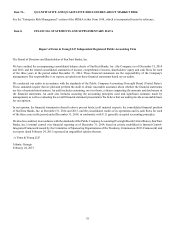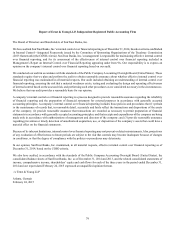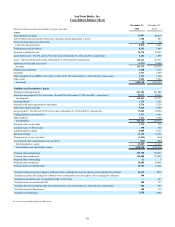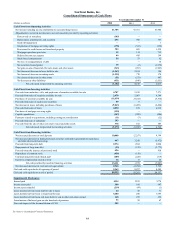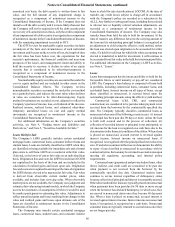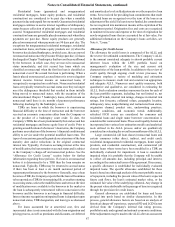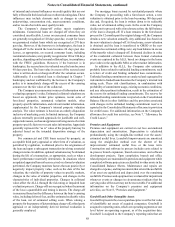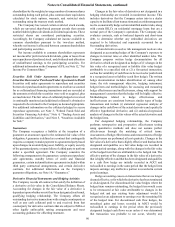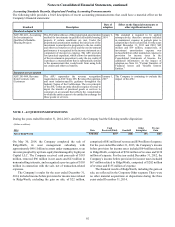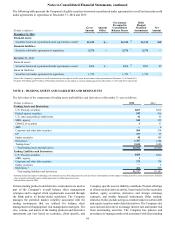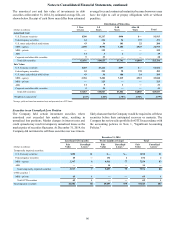SunTrust 2014 Annual Report Download - page 109
Download and view the complete annual report
Please find page 109 of the 2014 SunTrust annual report below. You can navigate through the pages in the report by either clicking on the pages listed below, or by using the keyword search tool below to find specific information within the annual report.Notes to Consolidated Financial Statements, continued
86
amortized cost basis, the debt security is written down to fair
value, and the full amount of any impairment charge is
recognized as a component of noninterest income in the
Consolidated Statements of Income. If the Company does not
intend to sell the debt security and it is more-likely-than-not that
the Company will not be required to sell the debt security prior
to recovery of its amortized cost basis, only the credit component
of any impairment of a debt security is recognized as a component
of noninterest income in the Consolidated Statements of Income,
with the remaining impairment recorded in OCI.
The OTTI review for marketable equity securities includes
an analysis of the facts and circumstances of each individual
investment and focuses on the severity of loss, the length of time
the fair value has been below cost, the expectation for that
security's performance, the financial condition and near-term
prospects of the issuer, and management's intent and ability to
hold the security to recovery. A decline in value of an equity
security that is considered to be other-than-temporary is
recognized as a component of noninterest income in the
Consolidated Statements of Income.
Nonmarketable equity securities are accounted for under the
cost or equity method and are included in other assets in the
Consolidated Balance Sheets. The Company reviews
nonmarketable securities accounted for under the cost method
on a quarterly basis, and reduces the asset value when declines
in value are considered to be other-than-temporary. Equity
method investments are recorded at cost, adjusted to reflect the
Company’s portion of income, loss, or dividends of the investee.
Realized income, realized losses, and estimated other-than-
temporary unrealized losses on cost and equity method
investments are recognized in noninterest income in the
Consolidated Statements of Income.
For additional information on the Company’s securities
activities, see Note 4, “Trading Assets and Liabilities and
Derivatives,” and Note 5, “Securities Available for Sale.”
Loans Held for Sale
The Company’s LHFS generally includes certain residential
mortgage loans, commercial loans, consumer indirect loans and
student loans. Loans are initially classified as LHFS when they
are identified as being available for immediate sale and a formal
plan exists to sell them. LHFS are recorded at either fair value,
if elected, or the lower of cost or fair value on an individual loan
basis. Origination fees and costs for LHFS recorded at LOCOM
are capitalized in the basis of the loan and are included in the
calculation of realized gains and losses upon sale. Origination
fees and costs are recognized in earnings at the time of origination
for LHFS that are elected to be measured at fair value. Fair value
is derived from observable current market prices, when
available, and includes loan servicing value. When observable
market prices are not available, the Company uses judgment and
estimates fair value using internal models, in which the Company
uses its best estimates of assumptions it believes would be used
by market participants in estimating fair value. Adjustments to
reflect unrealized gains and losses resulting from changes in fair
value and realized gains and losses upon ultimate sale of the
loans are classified as noninterest income in the Consolidated
Statements of Income.
The Company may transfer certain residential mortgage
loans, commercial loans, student loans, and consumer indirect
loans to a held for sale classification at LOCOM. At the time of
transfer, any credit losses subject to charge-off in accordance
with the Company's policy are recorded as a reduction in the
ALLL. Any further or subsequent losses, including those related
to interest rate or liquidity related valuation adjustments, are
recorded as a component of noninterest income in the
Consolidated Statements of Income. The Company may also
transfer loans from held for sale to held for investment. At the
time of transfer, any difference between the carrying amount of
the loan and its outstanding principal balance is recognized as
an adjustment to yield using the effective yield method, unless
the loan was elected upon origination to be accounted for at fair
value. If a held for sale loan for which fair value accounting was
elected is transferred to held for investment, it will continue to
be accounted for at fair value in the held for investment portfolio.
For additional information on the Company’s LHFS activities,
see Note 6, “Loans.”
Loans
Loans that management has the intent and ability to hold for the
foreseeable future or until maturity or pay-off are considered
LHFI. The Company’s loan balance is comprised of loans held
in portfolio, including commercial loans, consumer loans, and
residential loans. Interest income on all types of loans, except
those classified as nonaccrual, is accrued based upon the
outstanding principal amounts using the effective yield method.
Commercial loans (C&I, CRE, and commercial
construction) are considered to be past due when payment is not
received from the borrower by the contractually specified due
date. The Company typically classifies commercial loans as
nonaccrual when one of the following events occurs: (i) interest
or principal has been past due 90 days or more, unless the loan
is both well secured and in the process of collection; (ii)
collection of recorded interest or principal is not anticipated; or
(iii) income for the loan is recognized on a cash basis due to the
deterioration in the financial condition of the debtor. When a loan
is placed on nonaccrual, accrued interest is reversed against
interest income. Interest income on nonaccrual loans, if
recognized, is recognized after the principal has been reduced to
zero. If and when commercial borrowers demonstrate the ability
to repay a loan classified as nonaccrual in accordance with its
contractual terms, the loan may be returned to accrual status upon
meeting all regulatory, accounting, and internal policy
requirements.
Consumer loans (guaranteed and private student loans, other
direct, indirect, and credit card) are considered to be past due
when payment is not received from the borrower by the
contractually specified due date. Guaranteed student loans
continue to accrue interest regardless of delinquency status
because collection of principal and interest is reasonably assured.
Other direct and indirect loans are typically placed on nonaccrual
when payments have been past due for 90 days or more except
when the borrower has declared bankruptcy, in which case, they
are moved to nonaccrual status once they become 60 days past
due. When a loan is placed on nonaccrual, accrued interest is
reversed against interest income. Interest income on nonaccrual
loans, if recognized, is recognized on a cash basis. Nonaccrual
consumer loans are typically returned to accrual status once they
are no longer past due.



